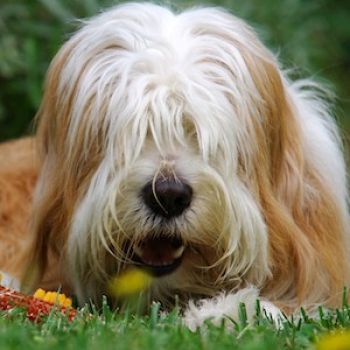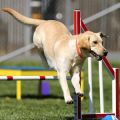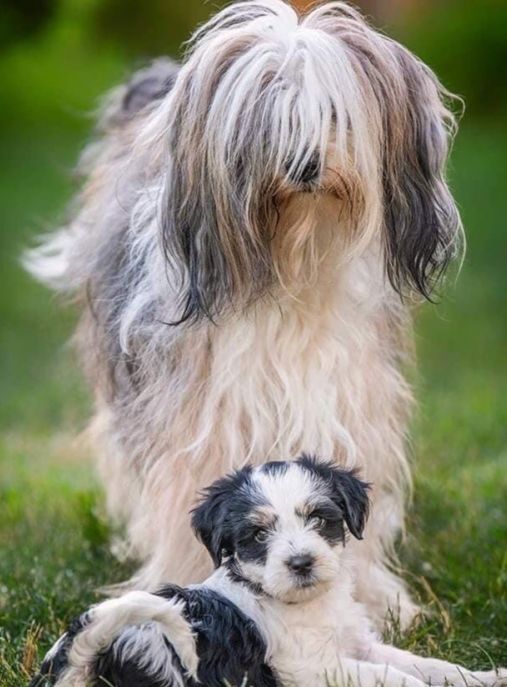The Tibetan Terrier is a charming and unique breed that has captured the hearts of dog lovers around the world. Known for their long, shaggy coats and friendly personalities, these dogs are often mistaken for small Old English Sheepdogs or Lhasa Apsos. However, the Tibetan Terrier is a breed in its own right, with a fascinating history and distinct characteristics.
Originating in Tibet, the Tibetan Terrier is believed to have been bred by Tibetan monks over 2,000 years ago. Revered as sacred dogs, they were kept in monasteries and served as companions, watchdogs, and even good luck charms. Despite their name, Tibetan Terriers are not true terriers but rather fall under the non-sporting group.
According to the Fédération Cynologique Internationale (FCI) typology, the Tibetan Terrier belongs to Group 9: Companion and Toy Dogs. This group includes various breeds that excel in providing companionship and are not specifically bred for working purposes. Within this group, the Tibetan Terrier is classified under Section 5: Tibetan breeds.
Tibetan Terriers are known for their versatility and adaptability. They make excellent family pets and are well-suited for individuals of all ages, including children and seniors. Their friendly and affectionate nature makes them wonderful companions, and they thrive on human interaction. Additionally, their intelligence and eagerness to please make them relatively easy to train.
In terms of physical characteristics, Tibetan Terriers are medium-sized dogs with a sturdy build. They typically weigh between 18 to 30 pounds (8 to 14 kilograms) and stand at a height of around 14 to 17 inches (35 to 43 centimeters) at the shoulder. Their most distinctive feature is their long, double coat, which consists of a soft, woolly undercoat and a thick, straight or wavy topcoat. This luxurious coat requires regular grooming to prevent matting and keep it looking its best.
The life expectancy of a Tibetan Terrier is generally between 12 to 15 years, although some individuals have been known to live even longer with proper care. They are generally healthy dogs, but like any breed, they can be prone to certain health issues. Some common conditions that may affect Tibetan Terriers include hip dysplasia, progressive retinal atrophy (PRA), and lens luxation. Regular veterinary check-ups and a balanced diet are essential for maintaining their overall well-being.
One interesting fact about Tibetan Terriers is that they are considered a hypoallergenic breed. While no dog is truly hypoallergenic, Tibetan Terriers produce fewer allergenic substances, such as dander, compared to other breeds. This makes them a suitable choice for individuals with allergies or sensitivities.
Another fascinating aspect of Tibetan Terriers is their unique foot structure. Their large, flat feet, similar to snowshoes, provide them with excellent traction and stability in the rugged terrain of their native Tibet. This feature, combined with their well-muscled hindquarters, enables them to navigate challenging landscapes with ease.
In conclusion, the Tibetan Terrier is a captivating breed with a rich history and distinctive characteristics. From their origins as sacred dogs in Tibetan monasteries to their role as beloved family pets today, these dogs have a special place in the hearts of many. With their friendly nature, adaptability, and striking appearance, Tibetan Terriers continue to bring joy and companionship to countless households worldwide.
The Tibetan Terrier is a unique and fascinating breed known for its charming personality and distinctive appearance. These dogs are often referred to as "Holy Dogs of Tibet" due to their historical association with Tibetan monasteries. With their friendly nature, intelligence, and adaptability, Tibetan Terriers make excellent companions for individuals and families alike.
In terms of physical characteristics, Tibetan Terriers are medium-sized dogs with a sturdy build. They have a double coat that consists of a soft, woolly undercoat and a longer, straight or wavy topcoat. Their coat comes in various colors, including white, black, golden, and tricolor. One of the most striking features of this breed is their expressive, dark eyes that radiate warmth and intelligence.
When it comes to their character, Tibetan Terriers are known for their affectionate and loyal nature. They form strong bonds with their owners and thrive on human companionship. These dogs are often described as being sensitive and intuitive, making them excellent therapy dogs. They have an uncanny ability to sense their owner's emotions and provide comfort and support when needed.
Tibetan Terriers are generally friendly and sociable with strangers, although they may be reserved initially. They are not typically aggressive but can be protective of their family and territory if they sense a threat. Early socialization is crucial to ensure they grow up to be well-rounded and confident dogs.
In terms of behavior, Tibetan Terriers are known for their playful and energetic nature. They enjoy interactive games and activities that challenge their intelligence. Regular exercise is essential to keep them physically and mentally stimulated. Daily walks, playtime, and puzzle toys can help meet their exercise needs and prevent boredom.
Training a Tibetan Terrier requires patience, consistency, and positive reinforcement techniques. These dogs are intelligent and eager to please, making them relatively easy to train. However, they can be independent thinkers at times, so it's important to establish yourself as a firm and consistent leader. Early obedience training and socialization are crucial to ensure they grow up to be well-behaved and obedient dogs.
Tibetan Terriers are generally good with children and other pets if properly socialized from a young age. However, as with any dog, supervision is necessary when introducing them to new situations or individuals. They have a moderate energy level, making them suitable for both active and more laid-back households.
Grooming a Tibetan Terrier requires regular maintenance due to their long, double coat. Daily brushing is necessary to prevent matting and keep their coat healthy and tangle-free. They are considered a hypoallergenic breed, as they shed minimally. However, regular grooming sessions, including bathing, ear cleaning, and nail trimming, are still necessary to keep them clean and healthy.
In conclusion, Tibetan Terriers are delightful companions with a loving and loyal nature. Their intelligence, adaptability, and playful demeanor make them a great addition to any family. With proper training, socialization, and care, these dogs can thrive and bring joy to their owners for many years to come.
The Tibetan Terrier is a charming and intelligent breed known for its long, flowing coat and friendly nature. To ensure the well-being and happiness of your Tibetan Terrier, it is essential to provide them with proper care and attention. Here are some tips on how to care for dogs of this breed, including what to do and what not to do:
1. Grooming:
- Do: Regularly brush your Tibetan Terrier's coat to prevent matting and tangles. Aim for at least two to three times a week.
- Do: Use a slicker brush or a comb with wide-spaced teeth to gently remove any loose hair and debris.
- Do: Trim the hair around their eyes to prevent irritation and maintain clear vision.
- Do: Schedule professional grooming sessions every six to eight weeks to keep their coat in top condition.
- Don't: Shave or cut their coat too short, as it provides protection from both heat and cold.
2. Exercise:
- Do: Provide daily exercise to keep your Tibetan Terrier physically and mentally stimulated. They enjoy walks, playtime, and interactive games.
- Do: Engage in activities that challenge their intelligence, such as obedience training, agility courses, or puzzle toys.
- Don't: Leave them alone for extended periods as they thrive on companionship and may become anxious or bored.
3. Training and Socialization:
- Do: Start training your Tibetan Terrier from an early age using positive reinforcement techniques. They are intelligent and eager to please.
- Do: Socialize them with various people, animals, and environments to ensure they grow up to be well-rounded and confident dogs.
- Don't: Use harsh training methods or punishment, as it can damage their trust and willingness to learn.
4. Nutrition:
- Do: Feed your Tibetan Terrier a balanced and high-quality diet that meets their nutritional needs. Consult with your veterinarian for specific recommendations.
- Do: Provide fresh water at all times and monitor their food intake to prevent obesity.
- Don't: Overfeed or give them excessive treats, as Tibetan Terriers can be prone to weight gain.
5. Health Care:
- Do: Schedule regular veterinary check-ups to monitor their overall health, vaccinations, and parasite prevention.
- Do: Keep their ears clean and dry to prevent infections. Regularly check for signs of redness, discharge, or foul odor.
- Do: Brush their teeth regularly and consider providing dental chews or toys to maintain good oral hygiene.
- Don't: Neglect their dental care, as dental issues can lead to more significant health problems.
6. Safety:
- Do: Provide a safe and secure environment for your Tibetan Terrier, both indoors and outdoors. Secure your yard with a fence to prevent them from wandering off.
- Do: Use a leash when walking them outside to ensure their safety and prevent them from chasing after small animals.
- Don't: Leave them unattended near open bodies of water, as Tibetan Terriers are not natural swimmers.
Remember, each Tibetan Terrier is unique, and their care may vary slightly. Pay attention to their individual needs, and always provide them with love, attention, and a nurturing environment. With proper care, your Tibetan Terrier will be a loyal and cherished companion for many years to come.
The Tibetan Terrier, a breed known for its unique and captivating appearance, comes in a variety of colors. However, one of the most common and distinctive colors found in Tibetan Terriers is a rich and lustrous shade of black.
The black coat of a Tibetan Terrier is truly a sight to behold. It is often described as deep and velvety, with a glossy sheen that adds to its allure. The color is evenly distributed throughout the entire body, from the top of the head to the tip of the tail. The black hue is so intense that it can sometimes appear almost like a midnight sky, creating a striking contrast against the dog's bright and expressive eyes.
Upon closer inspection, you may notice that the black coat of a Tibetan Terrier is not a solid color. Instead, it often exhibits subtle variations and undertones, which add depth and dimension to their appearance. These variations can range from a slightly lighter shade of black to a deep charcoal color, creating a beautiful play of light and shadow on their fur.
The texture of the black coat is another remarkable feature of Tibetan Terriers. It is dense and abundant, providing protection against the harsh weather conditions of their native Tibetan homeland. The fur is long and silky, falling in gentle waves that give the dog an elegant and regal appearance. This luxurious coat not only adds to their beauty but also serves as insulation, keeping them warm in cold climates.
In addition to their black coat, Tibetan Terriers may also have small patches of white on their chest, paws, or the tip of their tail. These white markings, known as "flash," further enhance their striking appearance and add a touch of charm to their overall look.
The black color of Tibetan Terriers is not only visually appealing but also holds cultural significance. In Tibetan culture, black is considered a symbol of protection and good luck. It is believed that the black coat of these dogs wards off evil spirits and brings prosperity to their owners.
In conclusion, the common color of Tibetan Terrier dogs is a captivating and rich black. This color, with its deep and velvety appearance, showcases the breed's elegance and beauty. The black coat, combined with its dense and silky texture, creates a stunning contrast against their bright eyes and adds to their regal presence. Whether seen in the sunlight or under the moonlight, the black coat of a Tibetan Terrier is a true testament to their unique and enchanting nature.
The Tibetan Terrier is a unique and beautiful breed known for its intelligence, agility, and friendly nature. When it comes to their health, Tibetan Terriers are generally considered to be a robust and healthy breed. However, like any other dog breed, they are prone to certain health issues. Understanding these common diseases and taking appropriate care can help ensure the well-being of your beloved Tibetan Terrier.
One of the most prevalent health concerns in Tibetan Terriers is hip dysplasia. This condition occurs when the hip joint doesn't develop properly, leading to discomfort, lameness, and arthritis. Regular exercise, a balanced diet, and maintaining a healthy weight can help reduce the risk of hip dysplasia. Additionally, responsible breeders perform hip evaluations on their breeding dogs to minimize the occurrence of this condition.
Another common health issue in Tibetan Terriers is progressive retinal atrophy (PRA). PRA is a degenerative eye disease that gradually leads to blindness. Regular eye examinations by a veterinary ophthalmologist can help detect PRA early on, allowing for appropriate management and care. It is advisable to avoid breeding dogs with a history of PRA to prevent passing on the condition to future generations.
Patellar luxation is another condition seen in Tibetan Terriers. It occurs when the kneecap slips out of place, causing pain and difficulty in movement. Regular exercise, maintaining a healthy weight, and avoiding excessive jumping or rough play can help prevent patellar luxation. Surgical intervention may be necessary in severe cases.
Tibetan Terriers are also prone to allergies, which can manifest as skin irritations, itching, and ear infections. Regular grooming, including brushing their long, double coat, can help prevent matting and reduce the risk of skin issues. Additionally, providing a balanced diet with high-quality ingredients can help support a healthy immune system and minimize the risk of allergies.
Dental health is crucial for Tibetan Terriers, as they are prone to dental problems like periodontal disease and tooth decay. Regular brushing of their teeth, providing dental chews or toys, and scheduling professional dental cleanings can help maintain good oral hygiene.
To ensure the overall health of your Tibetan Terrier, regular veterinary check-ups are essential. Vaccinations, parasite prevention, and routine blood tests can help detect any underlying health issues early on. Additionally, a nutritious diet tailored to their specific needs, regular exercise, and mental stimulation are vital for their well-being.
Lastly, providing a loving and stress-free environment is crucial for the mental health of Tibetan Terriers. They thrive on human companionship and require regular socialization to prevent behavioral issues.
In conclusion, while Tibetan Terriers are generally healthy dogs, they are prone to certain conditions such as hip dysplasia, PRA, patellar luxation, allergies, and dental problems. By being aware of these common health concerns and taking proactive measures such as regular veterinary care, appropriate exercise, a balanced diet, and grooming, you can ensure that your Tibetan Terrier leads a happy and healthy life.
The Tibetan Terrier is a small to medium-sized breed known for its long, thick, and double-coated fur. To ensure their overall health and well-being, it is crucial to provide them with a balanced and nutritious diet. Proper nutrition plays a vital role in maintaining their coat quality, supporting their immune system, and promoting their overall longevity. Here is an extensive description of the nutrition requirements for Tibetan Terrier dogs, along with advice on feeding and what to avoid.
1. High-Quality Protein: Protein is an essential component of a Tibetan Terrier's diet as it supports muscle development and repair. Look for dog food that contains high-quality animal-based proteins like chicken, beef, fish, or lamb. Avoid foods with excessive plant-based proteins or unidentified meat sources.
2. Balanced Diet: A well-balanced diet is crucial for Tibetan Terriers. It should consist of a combination of proteins, healthy fats, carbohydrates, vitamins, and minerals. Opt for dog food that is specifically formulated for small to medium-sized breeds and meets the nutritional guidelines set by reputable organizations like the Association of American Feed Control Officials (AAFCO).
3. Healthy Fats: Healthy fats are essential for maintaining a shiny and healthy coat. Look for dog food that contains omega-3 and omega-6 fatty acids, which can be found in ingredients like fish oil, flaxseed, or chicken fat. These fats also support brain development and promote a healthy immune system.
4. Carbohydrates: Carbohydrates provide energy for your Tibetan Terrier. Look for dog food that contains easily digestible carbohydrates like brown rice, sweet potatoes, or whole grains. Avoid foods with excessive amounts of corn, wheat, or soy, as these can cause allergies or digestive issues in some dogs.
5. Fiber: Adequate fiber is essential for maintaining a healthy digestive system. Look for dog food that contains natural sources of fiber like fruits, vegetables, or whole grains. This will help prevent constipation and promote regular bowel movements.
6. Avoid Fillers and By-Products: Avoid dog foods that contain excessive fillers like corn, wheat, or soy. These ingredients offer little nutritional value and can cause allergies or digestive issues. Additionally, avoid foods that contain by-products, artificial preservatives, colors, or flavors.
7. Feeding Schedule: Establish a regular feeding schedule for your Tibetan Terrier. Divide their daily food intake into two or three meals to prevent overeating and aid digestion. Avoid free-feeding or leaving food out all day, as it can lead to obesity.
8. Portion Control: Tibetan Terriers are prone to weight gain, so it's important to monitor their portion sizes. Follow the feeding guidelines provided on the dog food packaging, but adjust the amount based on your dog's age, activity level, and overall health. Regularly monitor their weight and adjust portions accordingly.
9. Fresh Water: Always provide fresh and clean water for your Tibetan Terrier. Hydration is crucial for their overall health and helps maintain proper organ function.
10. Regular Vet Check-ups: Regular veterinary check-ups are essential to monitor your Tibetan Terrier's overall health and nutritional needs. Your vet can provide specific dietary recommendations based on your dog's age, weight, and any underlying health conditions.
Remember, every dog is unique, and individual dietary needs may vary. It's always best to consult with your veterinarian for personalized advice on feeding your Tibetan Terrier.







